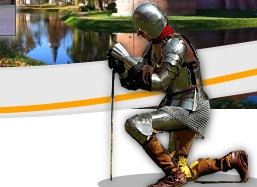| Apart from Teutonic castles, the monastic
state of the German German House of St. Mary in Jerusalem
held other castles, associated with the legal and material
status of the ecclesiastical dioceses. The division of lands
between the Order and the bishops and cathedral chapters took
place in 1243. There were two separate castles in Kwidzyn
- one which belonged to the bishop (called in German Altschloesschen)
and the other one, owned by the chapter, which, together with
the cathedral, formed a fortified compound.
The castle of the cathedral chapter was located in the north-west
part of the town. It was built in the Gothic style, of brick
laid on a stone base. The construction works went on from
1300 to 1330. The plan of the castle was typical of Teutonic
strongholds and represented the type of a convent house, which
consisted of a regular quadrangle with an inner court. The
castle wings were fortified with square towers raised in each
corner.
The state rooms were located on the first floor of the east
wing and included an infirmary (a hospital) and, most probably,
the apartment of the provost (the head of the cathedral chapter).
The same wing held the chapter's archives and treasury. The
south wing, which was the longest and the broadest, housed
the chapter room and the summer refectory as well as the library
and the rooms for scholars from the cathedral school. The
west wing contained the dormitory (bedroom) and was connected
with the gardrobe tower. The north wing held a small chapel
and the winter refectory. The ground floor of the north wing
still contains a medieval stove, which served for heating
the castle. The ground floor also comprised a number of service
rooms, such as a store for firewood, food store rooms, kitchens,
bakeries, and pantries. All the farm buildings which served
the castle, such as stables and barns, together with a brewery
and a garden, lay in the area in front of the castle, known
as the forecastle.
In the second half of the 14th century the finishing works
in the castle were completed and the cathedral was joined
with the east wing of the castle. The castle builders continued
work on the gardrobe and well towers as well as on a monumental
belfry, which connected the cathedral and the castle.
The castle of the Pomesania cathedral chapter in Kwidzyn has
the most impressive gardrobe tower among all Teutonic and
bishop's castles in the former state of the Teutonic Knights.
The gardrobe tower was raised on a square plan at a distance
of 54 m from the west wing of the castle. It is connected
with the castle by a roofed arcaded bridge, which stands on
five massive pillars. In the past, there was a stream which
was flowing under the tower, possibly a branch river of the
Vistula or the Stary Nogat rivers.
In the centuries which followed the castle was damaged and
reconstructed several times. The members of the Pomesania
chapter lived in the castle until the Reformation. Once the
Order of the Teutonic Knights had been secularised, the castle
was overtaken by protestant bishops, who lived here until
the mid-16th century. Later the castle was ceded to the Prussian
Duke, Albrecht. On his behalf the castle was run by head administrators
of the regional district (powiat). The castle interiors were
adapted to serve as apartments for ducal administration officials.
Following the first partition of Poland (1772), the south
and west wings of the castle housed the Higher Ducal and Land
Court of Justice. The refurbishment works which had been completed
then changed the layout of the rooms and corridors. In 1798
the Prussian authorities undertook an unfortunate decision
to pull down the south and east wings of the castle. The brick
obtained from the demolition was used to construct a new seat
for the Court of Justice of the so-called West Prussian Regency.
The castle was a seat of administration until 1935. From 1935
to 1945 it housed a school and an educational centre for Hitler
Youths. In 1945 the castle building was ceded to the Ministry
of Culture and Arts. Following some repairs, in 1950 Kwidzyn
Castle became a seat of a museum.
The collections of the Museum comprise material objects representing
the culture of Dolne Powi¶le, the land lying along the right
banks of the Lower Vistula river, including Kwidzyn, Sztum
and Susz regions.
Permanent exhibitions:
1. Tools of punishment and torture (16th - 18th centuries)
2. Artistic craftsmanship (15th - 20th centuries)
3. Baroque sculpture from Pomerania
4. The folk culture of Dolne Powi¶le
5. Nature in northern Poland
Museum in Kwidzyn
Branch of the Castle Museum in Malbork
ul. Katedralna 1, 82-500 Kwidzyn, Poland,
tel. +4855 64 63 797
www.zamek.malbork.pl |






![]()
![]() The
project is co-financed from the funds of the European Regional Development Fund,
under the framework of the Lithuania,
The
project is co-financed from the funds of the European Regional Development Fund,
under the framework of the Lithuania,